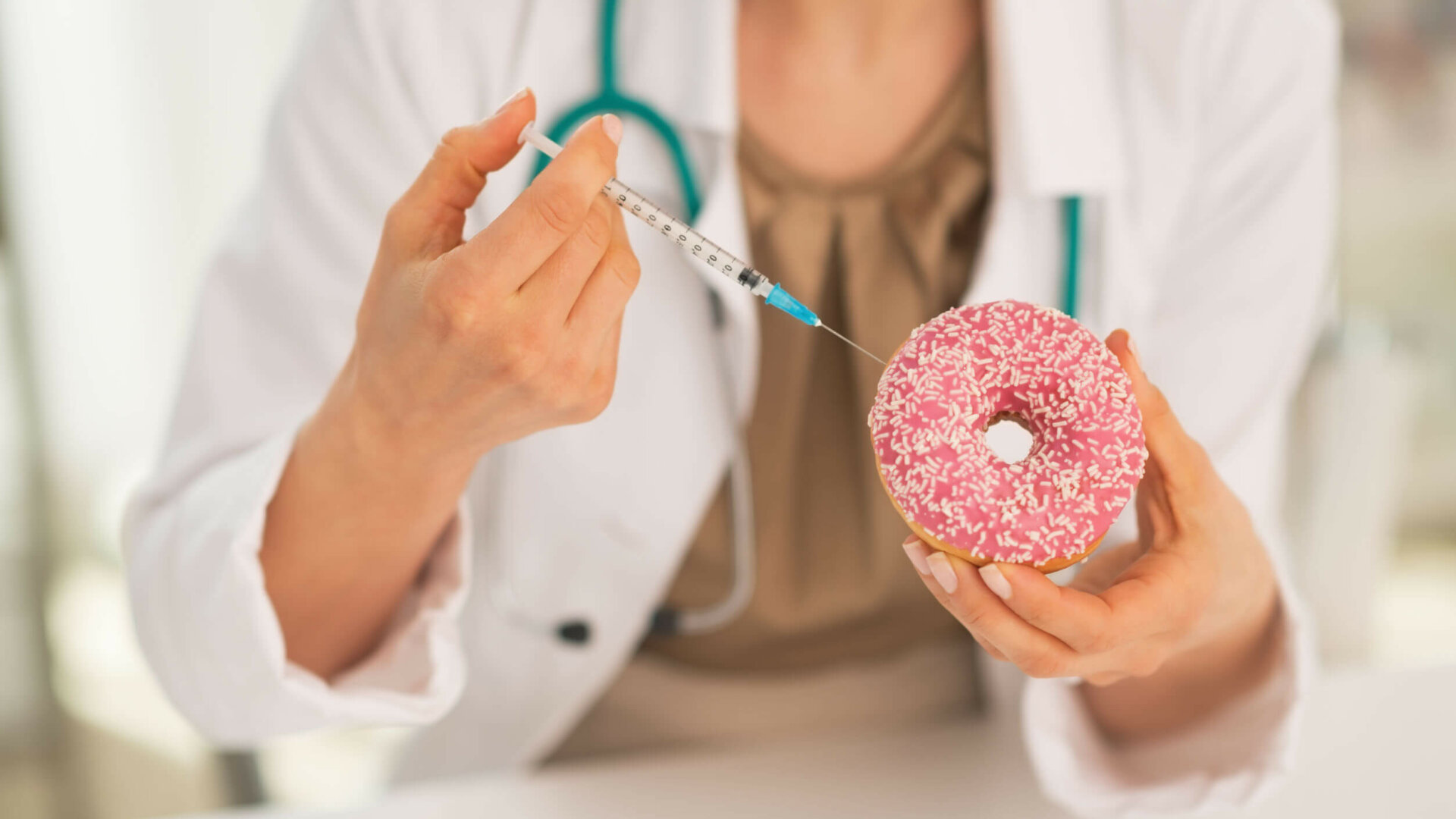Right now, it seems like everyone and their brother wants to lose weight to get ready for the summer.
- Get Shredded
- Get Lean
- Get Jacked
Whatever phrase you want to use, it all means the same thing:
I want to lose weight, especially fat.
This will always be a hot topic in the fitness and nutrition world, as well as within the general population. It’s hard enough to lose weight for a “healthy” individual with no chronic medical conditions. If you throw diabetes into the mix there are a few considerations to take into account with weight loss to ensure you do it safely.
Let’s get into it.
It’s about blood sugars and weight loss
First and foremost: the outcomes in this diabetes context are twofold:
- Managing blood sugar levels and keeping them in range
- Losing weight (predominantly fat)
At the end of the day, it makes not the slightest bit of difference if you lose weight if your blood sugar isn’t controlled, since poor glycemic control will set you up for micro and macrovascular complications, including but not limited to:
- peripheral neuropathy
- Retinopathy
- Nephropathy
- Cardiovascular disease
You get the idea. So, glycemic control is of the utmost importance.
Before I continue: increased insulin use is NOT associated with weight gain.
Many people assume that using more insulin will cause increases in weight. This stems from the initial weight gain experienced around diagnosis after intensive insulin therapy begins.
From another perspective: during that time immediately prior to diagnosis, blood sugars are extremely high since there is a paucity of insulin, so the glucose remains in the blood stream rather than being shuttled into cells. As a result, the body needs to expel it, and ultimately, it’s secreted in urine.
People ultimately will lose substantial body weight during this time [6].
Thus, when insulin therapy begins, that glucose that was being expelled is now being used in the cells, as it would be in a non-diabetic individual. No more urinating out calories, so the lost pre-diagnosis weight returns.
When people are years into diagnosis and are concerned with weight gain due to increased insulin utilization, it doesn’t cause the weight gain. Rather, the weight gain is caused by a vicious cycle that looks like this:
Low blood sugar correct with carbs (calories) –> overcorrection leads to high blood sugars and correction bolus –> too much insulin –> low blood sugar.
Lather. Rinse. Repeat.
Where in that cycle did insulin perpetuate the weight gain?
It didn’t. So, the moral of the story: There’s nothing to worry about. Manage blood sugars, and positive results will occur.
Weight gain or loss is a result of thermodynamics – energy in vs energy out.
While this premise isn’t absolutely complete here, it covers the majority of the premise.
This being said, with or without diabetes, the first logical step to achieving sustainable weight loss is to determine caloric need, per day, for weight maintenance, and through a combination of consumption and expenditure, end up in a negative energy balance.
Many of the recommendations for achieving long term, sustainable weight loss are very similar for those with or without diabetes: a negative energy balance, a diet with substantial protein for maximal retention of lean muscle mass and carbohydrates for further sparing of lean mass, and a quality resistance training program, as caloric restriction plus exercise elicits better weight and fat loss results than either in isolation [4][3][2].
However, a few considerations for this balance unique to diabetes:
1. Insulin sensitivity will increase substantially with caloric restriction
While this is a “nice to know” within a non-diabetes population, this is especially important for those with diabetes and especially those taking exogenous insulin. This concept has been demonstrated again and again within the research. In a population of overweight individuals, calorie restriction, with or without exercise, reversed insulin resistance and improved insulin sensitivity by 40-70% [1][5]. Another study showed this increase in insulin sensitivity was as large as 60-70% [3]. This is likely due to a decrease in inflammatory markers that are secreted by fat cells and can induce insulin resistance, thereby improving glucose disposal efficiency.
As a result of this increase in insulin sensitivity, when you begin a weight loss intervention, both basal and mealtime insulin will likely need an adjustment of some sort, as the risk for hypoglycemic episodes increases. Given the goal is achieving calorie restriction, additional calories from treating these low blood sugars will work against it. While I cannot give exact recommendations on insulin reduction, as I don’t know your particular situation, this is a major concept to be aware of, especially at the beginning of the journey.
With individuals I’ve worked with, this increase in insulin sensitivity affects them for two to three weeks before the body and insulin adjustments adapt.
2. Do everything in your power to NOT over treat low blood sugars
During low blood sugar episodes, hunger becomes dysregulated. In other words, you want to eat anything and everything in front of you.
On the other hand, for a hypoglycemic episode, you really only need 11-33g in most instances to correct [8]
So, while it may take everything out of you to not devour your fridge, taking the minimal amount of carbohydrate-based snack (with a little protein and/or fat to sustain blood sugars once they rise) will do you a great service in achieving your weight loss goals. If you need context as to how overcorrecting can be a problem, refer to the aforementioned vicious cycle above.
For an actionable tip you could start today, I would suggest leaving a “carb/calorie reserve” within your macronutrient plan for low blood sugars. For example, if your daily intake is 2400 kcal, consider eating 2300 kcal and leaving the other 100 kcal for low treatments. This way, you won’t exceed your caloric threshold if your blood sugar does end up low, and if you don’t, you can just consume it towards the end of the day.
3. Determine what macronutrient ratio works the best for you for keeping blood sugars in control
While carbs are important due to their protein-sparing effects, it is obvious that carbs are the most influential macronutrient with respect to blood sugars. Fat and protein both do impact blood sugars, but in a delayed fashion; fat through slowing digestion and protein through gluconeogenesis, where excess is converted to glucose, though this requires an excess of protein as well as a limited amount of carbs in the diet.
This being said, the percentage of carbs in the diet in a person with diabetes may vary from someone who doesn’t have diabetes. Some studies have demonstrated that individuals with diabetes consuming a higher proportion of calories from fat may actually lose more weight than those consuming a higher proportion of carbs, possibly due to the improved glycemic control associated with it [6][7].
However, does this mean you MUST follow a lower carb diet? Absolutely not. If your blood sugars are well controlled on a higher carb diet, then proceed onward with that – at the end of the day, remember, the goal is optimal blood sugar control.
The big picture
At the end of the day, there are some important considerations to keep in mind when losing weight and living with diabetes, especially if you are insulin-dependent. Of course, the same overarching themes in any successful weight loss program will be present, but these key blood sugar management principles should assist you, or at least give you some food for thought, in your upcoming weight loss quest.
References
- Larson-Meyer et al. (2006). “Effect of Calorie Restriction With or Without Exercise on Insulin Sensitivity,β-Cell Function, Fat Cell Size, and Ectopic Lipid in Overweight Subjects.” Diabetes Care. https://www.ncbi.nlm.nih.gov/pmc/articles/PMC2677812/
- Yassine et al. (2009). “Effects of Exercise and Caloric Restriction on Insulin Resistance and Cardiometabolic Risk Factors in Older Obese Adults—A Randomized Clinical Trial.” J Gerontol A Biol Sci Med Sci. https://www.ncbi.nlm.nih.gov/pmc/articles/PMC2691195/
- Shah et al. (2009). “Diet and exercise interventions reduce intrahepatic fat content and improve insulin sensitivity in obese older adults.” Obesity (Silver Spring). https://www.ncbi.nlm.nih.gov/pmc/articles/PMC2793412/
- Weiss, E. P et al. (2015). Calorie Restriction and Matched Weight Loss From Exercise: Independent and Additive Effects on Glucoregulation and the Incretin System in Overweight Women and Men. Diabetes care. https://www.ncbi.nlm.nih.gov/pmc/articles/PMC4477336/
- Johnson, M. L et al (2015). Mechanism by Which Caloric Restriction Improves Insulin Sensitivity in Sedentary Obese Adults. Diabetes. https://www.ncbi.nlm.nih.gov/pmc/articles/PMC4686951/
- Frisch S et al. (2009) A randomized controlled trial on the efficacy of carbohydrate-reduced or fat-reduced diets in patients attending a telemedically guided weight loss program. Cardiovasc Diabetol.
- Poynten AM et al (2003). Fat oxidation, body composition and insulin sensitivity in diabetic and normoglycaemic obese adults 5 years after weight loss. Int J Obes Relat Metab Disord.
- https://diatribe.org/issues/55/thinking-like-a-pancreas

